War Memorial Hall c1929

Herbert Fraser ‘Mac’ MORRISON
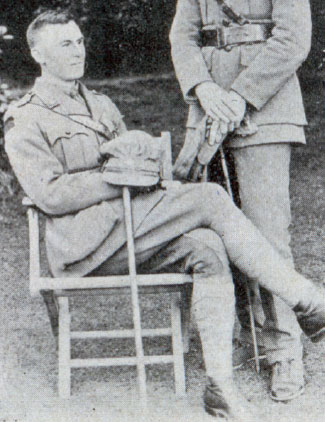
Mac Morrison was born on 5 December 1892 in Richmond, Victoria. His parents were Henry Howard and Esther (née Mark) Morrison. He attended Scotch from 1904 to 1908. Mac was a grandson of Alexander Morrison, principal of Scotch College from 1857 to 1903. At Scotch, Mac was in Cadets.
Mac was an an importer and grazier when he enlisted on 17 August 1914 at Prahran, Victoria. He served in the 5th Battalion with the rank of Lieutenant. His Regimental Number was 552.
Mac died on 10 August 1918 somewhere between Rosieres and Lihons, France. He was 25 years of age.
Service record
Mac enlisted as a Private and, like several other Scotch Collegians, was allotted to the Public Schools Company of the 5th Battalion. After six months he was appointed Lance Corporal, in February 1915. He was at the Landing at Gallipoli on 25 April. He reportedly proved his leadership qualities that day, though in his own words ‘I only lasted until the evening, when I was shot through the leg.’ He had to walk to the beach – he estimated the distance as three miles – before the calf wound was attended to. ‘On the way down’, he recalled, ‘those dreadful snipers were shooting at the wounded’. The wound to his calf was characterised as slight but necessitated treatment in Egypt for two weeks.
He then returned to Gallipoli, even though his wound was not fully healed. On 9 May Mac was appointed Corporal. It was probably soon after this that he wrote a most interesting letter about his Gallipoli experiences that was reproduced in the Collegian. He told of the landing, which he said was completely silent until they got ashore, after which they were constantly under fire. He spoke of the fighting as fascinating. ‘At first’, he said, ‘I used to dodge everything that exploded within a mile, but I soon got tired of that. The shells burst so close to me sometimes that I felt their heat on the back of my neck.’ One close shot cut his sleeve in two places, hurt his wrist and sent dust into his face and eyes. He remarked that, strange though it seemed, he was smoking his pipe in the middle of it.
He said of his fellow soldiers, ‘The men were just great’, and that whenever they had to get up to charge, ‘there was always some joke cracked.’ Indeed, he felt, ‘it is awfully funny here.’ He described the men living like rabbits in holes on the side of a hill. He made a major jump on 4 August 1915, when he was promoted to 2nd Lieutenant and became a platoon commander. However, he then contracted dysentery and on 1 September was evacuated.
He travelled first to Malta and then to England. In February 1916 he embarked again, for Egypt. He boarded a ship again on 31 May, this time going to England once more. He joined the 5th Battalion again in France on 26 July 1916. They were at the time suffering heavy casualties in the fighting for Pozieres. His cheerfulness and coolness under fire in the Pozieres fighting reportedly ‘put heart into all who came into contact with him.’
On 9 September 1916 Mac became a full Lieutenant but on 20 or 21 September in a quiet sector near Ypres in Belgium he received a gunshot wound to the left eye. His friend and fellow officer Cyril Lillie explained that ‘one morning, shortly after “stand down,” Mac was looking over the parapet for an enemy sniper. Unfortunately, he was “spotted,” and the sniper hit his tin hat, splashing a piece into his eye.’ The 23-year-old’s eye was ‘enucleated’ (removed) at Boulogne on 22 September. On 24 September he was in hospital again in London, just as he had been 12 months earlier.
A medical report of 4 October said that he was waiting for ‘fixation of artificial eye’ (see below). Mac’s service file contains a letter, dated December 1916, from the commanding officer of the 5th Battalion to ‘Morrison’, clearly in response to a request from Mac that he be allowed to return to the battalion despite his artificial eye (see below). He was reportedly posted to a semi-military position as Adjutant of the Australian Munition Workers in England. He repeatedly sought permission from Medical Boards to be classified fit to return to the front. A Medical Board file from January 1917 shows that his ‘artificial eye [is] now fitted causing no trouble.’ He was discharged from hospital in February 1917. In March a Medical Board noted that ‘The sight in the other eye is good.’
In May 1917 he was permitted to return to France, where on the 25th he rejoined the 5th Battalion. He became second in command of a company under Captain Cyril Lillie, a distinguished officer of the unit and an Old Scotch Collegian who had been with Mac since the Gallipoli landing. Lillie later called the next three months of training in’Mac’s jolly company’ as ‘the happiest I spent in the army.’ Lillie was recovering from wounds when he wrote home that in recent fighting, ‘my second in command…is Mac. Morrison, old Scotch Collegian, one of the best fellows out. He came back to the war after losing an eye. They all say the old company did fine.’ Mac did particularly well.
On 1 January 1918 he was awarded the Military Cross for his role in the fighting at Black Watch Corner, near Ypres, on 20 September 1917. There he had shown ‘judgment and coolness and instilled confidence in his men by continually moving from post to post over ground swept by machine guns and snipers.’ (see below). Captain Stan Neale, former school captain who had been in the same platoon as Mac for much of the Gallipoli campaign, wrote in 1918 that Mac, ‘with his one eye, looks very aggressive.’ He recorded that ‘I did not see him after the Ypres stunt, but I am told that his appearance – a stubbly four-days’ beard and a muddy eye – was beyond description.’
On 3 May 1918 Mac was wounded for the third time, but remained on duty. Cyril Lillie recorded that ‘With Mac still as second in command, C Company, we had a few rather exciting times in stopping the Bosche [German] advance on Hazebrouck’ during the major German offensive of that period. When Lillie was called to England in late July 1918, ‘Mac Morry’ took over his company. During the attack between Lihons and Rosieres – fighting which cost the lives of at least four Scotch Collegians - communication between units was often poor, and at one point Morrison took an important initiative by pushing his own company into a dangerously exposed gap between two other battalions.
On 10 August he was moving from a support trench to the front line when he was hit yet again, with a wound to the chest (some sources say the stomach) and was categorised as ‘Dang wd’ [dangerously wounded]. The eyewitness accounts do not agree on the exact cause of Mac’s wounds, but several mention that he was hit by machine gun fire. The chaplain in the 20th Casualty Clearing Station, where he was taken, said he was also badly wounded in the spine. He succumbed to his wounds that day.
In Mac’s Red Cross Wounded and Missing file there is testimony from a Private David Doyle, who described Mac as ‘a very fine soldier and most popular with everyone’. He also said that ‘the following morning Mr Morrison’s brother [‘Mr’ was the standard term for a Lieutenant], who was in D. Coy. came over to take his brother’s place in C. Coy. and about 3 a.m. he evidently missed his way for he walked straight into Fritz’s lines and got taken prisoner.’ Indeed his brother and fellow Scotch Collegian Clive, known as ‘Rooster’, was in fact captured. Cyril Lillie wrote to the Collegian about Mac, giving a lengthy account of Morrison’s service alongside him in the 5th Battalion. He started by mentioning that he had enclosed a photograph (now apparently lost) showing Mac’s grave: ‘the cross, which is of oak, has the School badge worked on the top of it.’ He concluded by talking about the fact that Mac ‘never seemed to grow old [not surprising, as he was only 25 at his death, though his experience of battles from 1915 to 1918 certainly qualified him as a veteran], and was always ready for any boyish pranks.’
He had the ability to cheer up the officers whenever life in the officers’ mess became dull. With a reference to Scotch, Lillie said that ‘public school life teaches us many good qualities which perhaps cannot be learnt elsewhere, and throughout his military career these qualities seemed to shine out in Mac more than in anyone else.’ ’At his brother Eric’s direction, Mac’s headstone at Vignacourt is inscribed with the words: ‘Died for his country.’ Cyril Lillie concluded his obituary of Mac in The Scotch Collegian by asserting that ‘in the battalion and among his friends his memory will always remain dear, and their consolation for the loss of his friendship will always be the cause for which he fell – Deo, Patriae, Litteris.’
Mac Morrison is buried in the Vignacourt British Cemetery (Plot V, Row D, Grave No. 8), France.
Photographs and Documents:
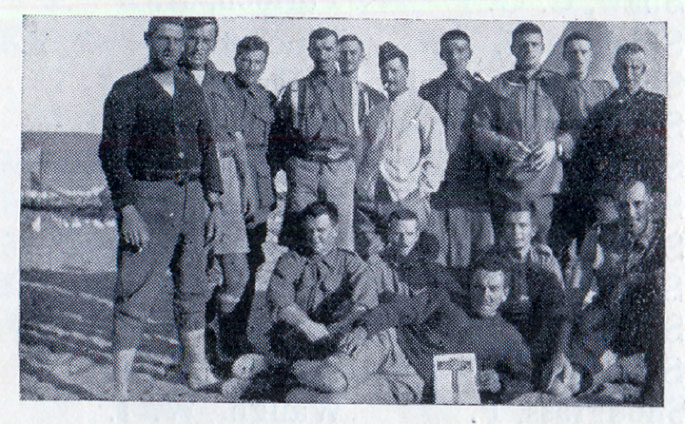
Lance Corporal ‘Mac’ Morrison is fifth from the left in the back row of this photograph of Old Scotchies at Mena Camp, Egypt in 1915.
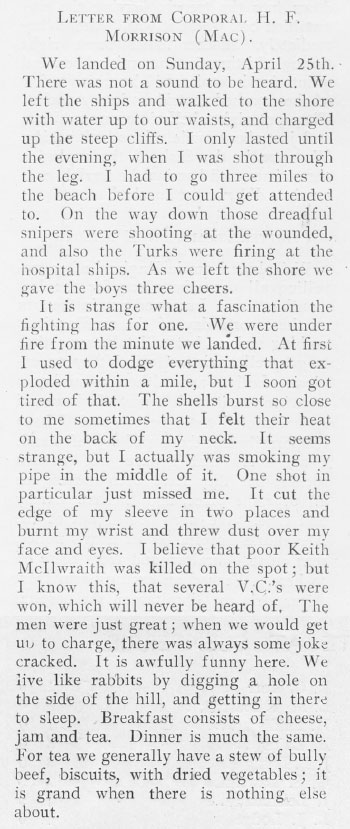
Mac’s letter from Gallipoli, written some time after his promotion to Corporal on 9 May.
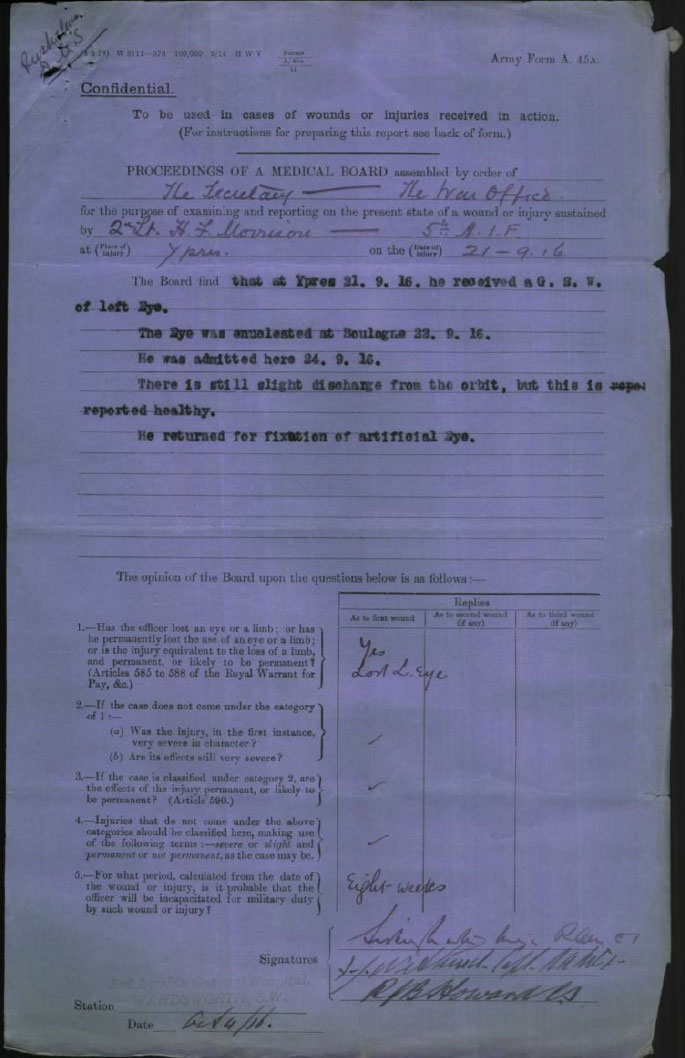
Medical file concerning Mac’s lost eye.
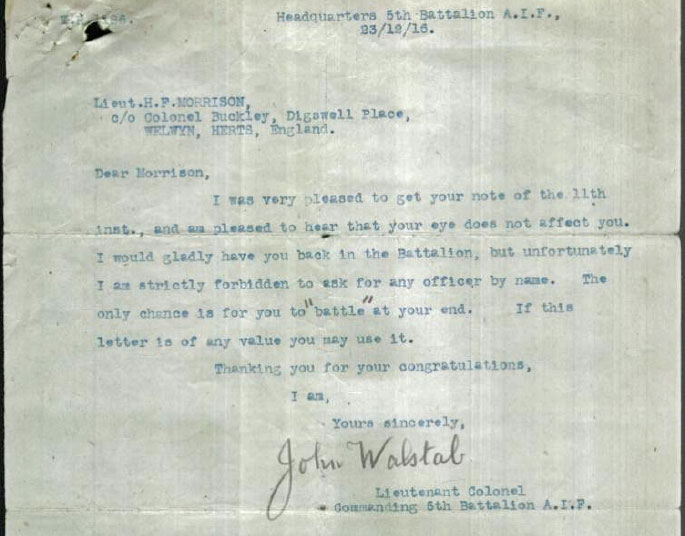
Letter from Mac’s Commanding Officer concerning his wish to return to the 5th Battalion despite his lost eye.
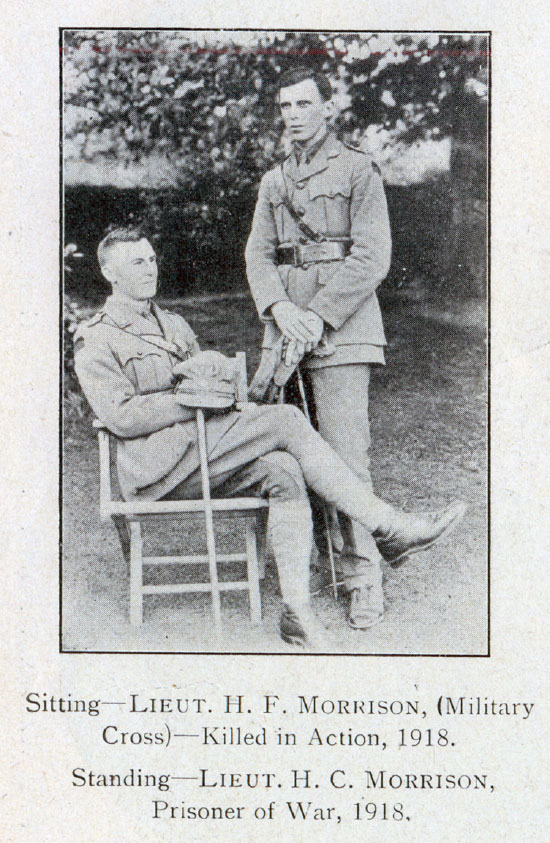
In this undated photograph of Mac and his brother Clive, Mac’s left eye looks as if it may be the artificial one fitted in late 1916 or early 1917. Clive was wounded three times during the war.The recommendation for Mac’s Military Cross
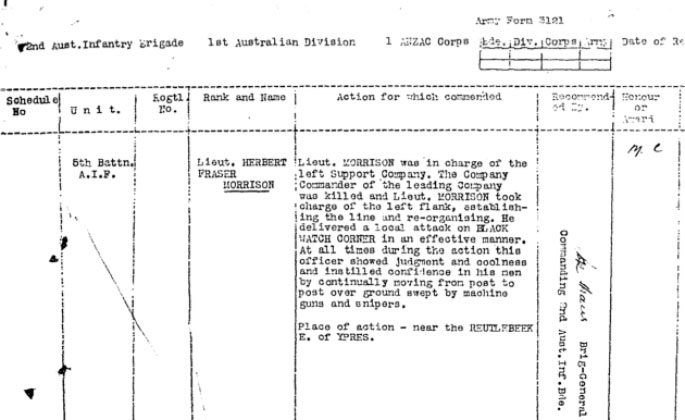
The recommendation for Mac’s Military Cross
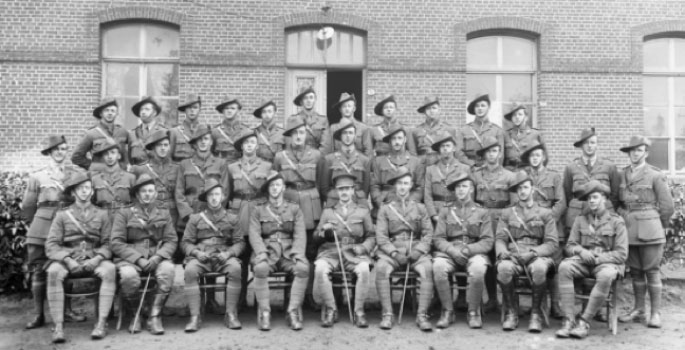
Lieutenant ‘Mac’ Morrison is sixth from the left in the back row of this photograph of 5th Battalion officers at Locre (near Ypres), Belgium in February 1918. Three others in the pictured group would die in the year ahead.
Sources:
- Australian War Memorial – Roll of Honour and Red Cross Wounded and Missing file
- Commonwealth War Graves Commission website
- Mishura Scotch Database
- East Melbourne Historical Society website, http://emhs.org.au/person/morrison/herbert_fraser
- National Archives of Australia – B2455, MORRISON HERBERT FRASER
- Scotch Collegian 1915, 1917, 1918 and 1919
- The AIF Project - https://www.aif.adfa.edu.au/showPerson?pid=215260


